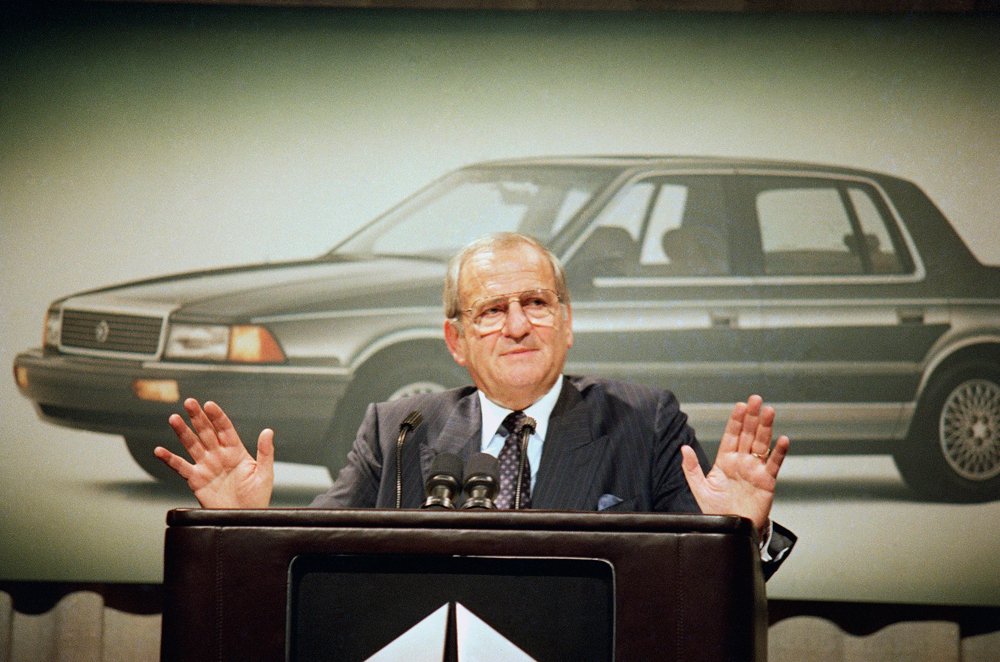Lee A. Iacocca, the visionary automaker who ran the Ford Motor Company and then the Chrysler Corporation and came to personify Detroit as the dream factory of America’s post-war love affair with the automobile, died on Tuesday at his home in Bel Air, California. He was 94.
He had complications from Parkinson’s disease, a family spokeswoman said.
In an industry that had produced legends, from giants like Henry Ford and Walter Chrysler to the birth of the assembly line and freedoms of the road that led to suburbia and the middle class, Iacocca, the son of an immigrant hot-dog vendor, made history as the only executive in modern times to preside over the operations of two of the Big Three automakers.
In the 1970s and ’80s, with Detroit still dominating the nation’s automobile market, his name evoked images of executive suites, infighting, power plays and the grit and savvy to sell American cars. He was so widely admired that there was serious talk of his running for President.
Detractors branded him a Machiavellian huckster who clawed his way to pinnacles of power in 32 years at Ford, building flashy cars like the Mustang, making the covers of Time and Newsweek and becoming the company president at 46, only to be fired in 1978 by the founder’s grandson, Henry Ford II.
But admirers called him a bold, imaginative leader who landed on his feet after his dismissal and, in a 14-year second act that secured his worldwide reputation, took over the floundering Chrysler Corporation and restored it to health in what experts called one of the most brilliant turnarounds in business history.
He accomplished it with a controversial $1.5 billion federal loan guarantee, won by convincing the government that Chrysler was vital to the national economy and should not be allowed to fail, and with concessions from unions, new line-ups of cars, and a new national spokesman — himself — featured in a decade-long television advertising campaign.
“If you can find a better car, buy it,” the blunt Iacocca challenged the public. “I’m not asking you to buy any car on faith. I want you to compare.”
As the 1980s unfolded, his commercials hammered at a theme: “The pride is back.” And so it seemed. The guaranteed loans were repaid in four years, seven years early. Americans were buying cars at a record clip again, including Chrysler’s new minivans and compacts. The company’s $1.7 billion loss in 1980 had become a $2.4 billion profit by 1984.
Chrysler was selling cars as fast as it could make them. Its stock price soared, as did Iacocca’s popularity. His achievement in restoring Chrysler was all the more impressive because it had begun in a national recession and matured against intense competition from America’s larger automakers, Ford and General Motors, and from a rising tide of imported cars from Japan and other countries.
His book Iacocca: An Autobiography (1984, written with William Novak) became a runaway bestseller, the leading non-fiction hardcover of 1984 and 1985. With tens of millions of copies in print, it still regales readers with its intimate look at the auto industry of Iacocca’s day, its cast of larger-than-life characters, its accounts of the author’s dismissal at Ford and his rescue of Chrysler.
In 1987, the company that had nearly failed posted sales of $26 billion and sat on a $3 billion cash cushion. Iacocca, who had taken only $1 as compensation in the first year after winning the loan guarantee, was now the industry’s most highly paid executive, with salary and stock options worth $18 million.
Television commercials and news photographs had made him one of the nation’s best-known faces, an oval of grandfatherly features: a balding pate, a fleshy nose, mischievous eyes behind half-rim glasses, thin lips chomping an imported cigar, and a bland political smile that gave away nothing.
A heroic figure to many Americans, he became chairman of a project to restore the Statue of Liberty and Ellis Island, and was in demand for speeches and public appearances that took on the colour of a campaign. He conferred with President Ronald Reagan, members of Congress, governors and business leaders. He was mobbed by admirers and pursued by the press. Polls confirmed that a run for the White House was realistic, and his denials of political ambition only fuelled public interest in a possible candidacy.
But by the late 1980s, storm clouds that Iacocca and other auto executives had long ignored were gathering. The stock market had plunged in 1987, and Japan, long since recovered from the disasters of World War II, had become a world-class economic power, whose fuel-efficient cars were flooding the US. Americans wanted reliable, well-built cars with innovations like airbags, and Honda and Toyota were supplying them.
Iacocca, as he acknowledged, had drifted too far from day-to-day operations. Instead of reinvesting in new models to rival Japanese imports, he had aggressively expanded into other ventures, acquiring the corporate jet manufacturer Gulfstream and American Motors, a small competitor. By the 1990s, many American cars could not compete with Japanese innovations.
The Iacocca magic, like Chrysler’s earnings, faded as the nation dipped into recession. He persuaded Congress to give some protection to the American auto industry from imported cars, but Japan just set up factories to build cars in the US.
In 2008, months before Chrysler and General Motors declared bankruptcy after years of mounting losses, Iacocca visited Auburn Hills and was greeted with thunderous applause by a thousand Chrysler workers.
“Don’t get panicked,” he told them. “Things are going to be OK Now is the time to show your stuff. We don’t have any alibis. The truth is automobiles in America are still a vital business.”











